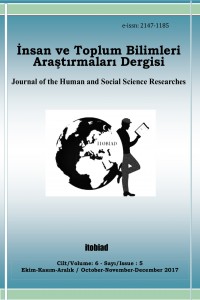Abstract
Fairy tales, one of the
oldest literary genres, have been studied using different methods and
approaches. Semiotics, which investigates not only linguistic but also
non-linguistic signs and looks for regular patterns in literal texts, is one of
these approaches. In this study, the fairy tale Hansel and Gretel, which is one
of those collected by Grimm Brothers, was examined using a semiotic method according
to the actantial model of Greimas. In
the process of the analysis, the linguistic and fictional features of the tale
were considered, but the deep semantic structure of the text was excluded. Considering
the plot, the tale was divided into four segments. It was seen that the six
actants of the model took place in these segments and the functions of the
actants in the tale overlapped with their place on the model. The result of the
study showed that the model revealed the fictional structure and production
processes of the tale.
References
- Asutay, H. (2013). Çocuk Yazınının Fantastik Dünyası: Masallar. Turkish Studies, 8(13), 265-278.
- Erkman-Akerson, F. (2005). Göstergebilime Giriş. İstanbul: Multilingual
- Grimm, J. & W. (2011). Grimm Masalları, s.18-23. (E. Portakal, Çev.). İstanbul: Bilge Kirpi Yayıncılık.
- Günay, U. T. (2011). Elazığ Masalları ve Propp Metodu. Ankara: Akçağ
- Kıran A. & Z. (2011). Yazınsal Okuma Süreçleri. Ankara: Seçkin Yayıncılık.
- Parsa, S & A. F. (2004). Göstergebilim Çözümlemeleri. İzmir: Ege Üniversitesi Basımevi.
- Propp, V. (1968). Morphology of the Folktale. Austin: University of Texas Press
- Rifat, M. (2007). Homo Semioticus ve Genel Göstergebilim Sorunları. İstanbul: Yapı Kredi Yayınları.
- Rifat, M. (2013). XX. Yüzyılda Dilbilim ve Göstergebilim Kuramları. İstanbul: Yapı Kredi Yayınları.
- Rifat, M. (2009). Göstergebilimin ABC’si. İstanbul: Say Yayınları.
- Saussure, F. (1959). Course in General Linguistics. New York: Philosophical Library
- Şirin, M. R. (2007). Masal Atlası: Masal Edebiyatı Kültürü Üzerine Yazılar. Ankara: Kök Yayıncılık
- Yücel, T. (1982). Yapısalcılık. İstanbul: Ada Yayınları
- Zipes, J. (2003).The Brothers Grimm: From Enchanted Forests to the Modern World. New York: Palgrave Macmillan.
Abstract
En eski edebî
türlerden birisi olan masallar, değişik
yöntem ve yaklaşımlarla incelenmeye çalışılmıştır. Sadece dilsel
göstergeleri değil, dil dışı göstergeleri de inceleyen; dilde var olan evrensel
yapıları edebî metinlerde de araştıran göstergebilim bu tür yaklaşımlardan
birisidir. Bu çalışmada, Grimm
Kardeşlerin derlediği masallar arasında yer alan Hansel ve Gretel adlı eser,
Greimas’ın eyleyenler modeline göre göstergebilimsel bir yöntemler
incelenmiştir. Masal incelenirken, masalın yüzeysel ve sözdizimsel anlatı
boyutları dikkate alınmış, temel anlamsal boyut incelemesi kapsam dışı
tutulmuştur. Olay örgüsüne bakarak çalışmaya konu olan masal dört kesite
ayrılmış, bu kesitlerde Greimas’ın modelindeki altı eyleyenin de bulunduğu,
eyleyenlerin masaldaki fonksiyonları ile modelde bulundukları yerlerin
birebir örtüştüğü görülmüştür. İnceleme sonucunda modelin, masalın kurgusal
yapısını ortaya koyduğu, üretim süreçlerini görünür kıldığı saptanmıştır.
References
- Asutay, H. (2013). Çocuk Yazınının Fantastik Dünyası: Masallar. Turkish Studies, 8(13), 265-278.
- Erkman-Akerson, F. (2005). Göstergebilime Giriş. İstanbul: Multilingual
- Grimm, J. & W. (2011). Grimm Masalları, s.18-23. (E. Portakal, Çev.). İstanbul: Bilge Kirpi Yayıncılık.
- Günay, U. T. (2011). Elazığ Masalları ve Propp Metodu. Ankara: Akçağ
- Kıran A. & Z. (2011). Yazınsal Okuma Süreçleri. Ankara: Seçkin Yayıncılık.
- Parsa, S & A. F. (2004). Göstergebilim Çözümlemeleri. İzmir: Ege Üniversitesi Basımevi.
- Propp, V. (1968). Morphology of the Folktale. Austin: University of Texas Press
- Rifat, M. (2007). Homo Semioticus ve Genel Göstergebilim Sorunları. İstanbul: Yapı Kredi Yayınları.
- Rifat, M. (2013). XX. Yüzyılda Dilbilim ve Göstergebilim Kuramları. İstanbul: Yapı Kredi Yayınları.
- Rifat, M. (2009). Göstergebilimin ABC’si. İstanbul: Say Yayınları.
- Saussure, F. (1959). Course in General Linguistics. New York: Philosophical Library
- Şirin, M. R. (2007). Masal Atlası: Masal Edebiyatı Kültürü Üzerine Yazılar. Ankara: Kök Yayıncılık
- Yücel, T. (1982). Yapısalcılık. İstanbul: Ada Yayınları
- Zipes, J. (2003).The Brothers Grimm: From Enchanted Forests to the Modern World. New York: Palgrave Macmillan.
Details
| Journal Section | Articles |
|---|---|
| Authors | |
| Publication Date | December 31, 2017 |
| Published in Issue | Year 2017 Volume: 6 Issue: 5 |


